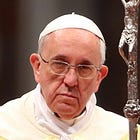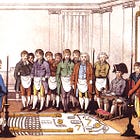2 weeks or 60 years: Which fits Franzelin's account of sede vacante?
Cardinal Franzelin's account of the period of sede vacante shows us what can and cannot happen during a papal interregnum. Do you think it best fits 2 weeks… or 60 years?

Cardinal Franzelin's account of the period of sede vacante shows us what can and cannot happen during a papal interregnum. Do you think it best fits 2 weeks… or 60 years?
Editor’s Notes
(WM Review)—This week, the Vatican’s cardinals are entering the Sistine Chapel to elect a man to succeed Francis.
This conclave will start on 7 May, following his death on 21 April 2025—just over two weeks ago.
Over the last two weeks, many people have made the same hilarious joke:
“We're all sedevacantists now.”
We have previously commented on this joke, noting that it is based on a misunderstanding, and that many of those whose “sedevacantism” dates from 21 April 2025 will promptly accept whoever appears on the balcony of St Peter’s—be it Pope Aveline, Pope Susan or even Pope Bronzehead1—even if such acceptance radically undermines Catholic theology and teaching on the Church and the papacy itself.
In this article, we do not intend to make the case for a vacancy extending back to around 1965 or so: instead, we want to pose a question for reflection.
This present text
Cardinal Johann Baptist Franzelin (1816–1886) was a Jesuit theologian renowned for his intellectual rigour, ascetic lifestyle, and deep humility. Born in poverty in Tyrol, he rose through Jesuit academic ranks despite poor health, eventually becoming a leading professor of dogmatic theology at the Roman College and a key theological figure at the First Vatican Council. Appointed cardinal by Pius IX against his will, he remained devoted to poverty, prayer, and scholarship, distributing his income to the poor and foreign missions. His treatises—especially De Divina Traditione et Scriptura—are considered classical and influential among clergy worldwide.
The following, translated by Mr James Larrabee is taken from that text. Based on this text, we invite readers to consider the question in the headline above:
Does this text from Franzelin better describe the last two weeks, or the last sixty years?
At first glance, one might assume the former. But effects arise from proportionate causes. The problem of our day is that many have lost a sense of the true Catholic teaching on the Church and the papacy—not least by their acceptance of the recent papal claimants. As a result, they are not able to see the radical disconnect between what the Roman Pontiff is for and necessarily achieves, and the evident fact that this is not happening in our day. To avoid this conclusion, they present an exaggerated strawman of the former, and describe it as hyperpapalism or ultramontanism.
Whether through ignorance or bad will, they do not grapple with the actual arguments—namely that the pope is efficient cause of unity,2 and that the unity of which he is the cause—that of faith, government and worship—is a perpetual and necessary property of the Church, as well as a necessary and visible mark by which she may be known as the true Church.
This visible unity of faith is manifestly absent in the self-titled Conciliar/Synodal Church, which thus demonstrates that it is not the Catholic Church, and that she has been without a reigning Roman Pontiff since the 1960s. But because so many do not know any better, and because it is such an initially startling proposition, they are more inclined to deny that this visible unity is a true property of the Church than to recognise the comedic imposture as such.
The seat can never fail
Franzelin is describing the state of the Church without that efficient cause of unity, and considering what is necessarily sustained in the Church even during a papal interregnum, and what evils or difficulties may befall her in this time.
For example, Franzelin says:
[T]he seat can never fail, but it can be vacant and often is vacant.
Although our friends would deny it, the promulgation of condemned errors by a true pope would indeed constitute the failure of the seat. The circumstances of our day require us to draw one of the following conclusions:
These condemned errors have not been promulgated by a true pope
That what has been promulgated are not actually condemned errors
That traditional theology and teaching on the question were mistaken and need to be rethought.
The first conclusion is the only one that violates neither the facts nor our duties as Catholics.
Franzelin does not demand a short vacancy
Franzelin continues, talking of periods of vacancy:
Then indeed the divine law and institution of perpetuity remains, and by the same reason the right and duty in the Church of procuring the succession according to the established law.
He does not say “divine law and institution of perpetuity remains so long as the vacancy is short,” or “so long as the established (positive) law is possible to execute,” as if devolution from positive law would be impossible, or constitute a defection of the Church.
Indefectibility in procuring a successor simply does not mean procuring a successor promptly according to positive law. If it did, theologians would not have discussed what would occur if positive law became impossible to fulfil. This indefectibility means that the Church will eventually restore succession, in a way that is lawful—even if unusual.
There is no divine promise that this happens on the world’s timeline—or according to modern bureaucratic expectations. The Church is not a conclave machine.
The indefectibility of the Church remains
Franzelin adds that the Church remains infallible in her faith as believed, taught and professed. He concludes from this:
[N]either the whole body of the Church in its belief, nor the whole Episcopate in its teaching, can depart from the faith handed down and fall into heresy.
There are two points to note here.
The first pertains to Vatican II’s errors. It is disputed as to whether the errors of this council are properly classed as heresies—although the errors themselves do serve as infallible signs of the vacancy from around 1965. While it is impossible for an ecumenical council, confirmed by the pope, to have promulgated such errors, it is possible for a council without a pope. Ergo, etc.
The second pertains to the consequences of bishops signing or accepting the documents of such a council. Some claim that all the bishops accepted the council, and so fell into heresy and thus lost office. However, there are several problems with this analysis. John S. Daly—who himself was responsible for discovering these signatures in the Acta Synodolia and publishing them in a sedevacantists periodical—raises the following points relevant to this matter:
Vatican II promulgated sixteen documents, but only six lists of signatures are appended to them. It is true that all six were signed by the bishops, including by those “who later came to be associated with the traditional resistance” (Lefebvre, Thuc and de Castro Mayer). Lefebvre, however, denied having signed the documents. Was he lying, or confused? “There is thus a serious doubt of fact at the heart of the issue: what documents do the six signature lists relate to and what did the bishops understand their signatures to imply?”
Daly also refers to the Council of Rimini (357) in which “almost all of the Western bishops were prevailed upon to sign a heretical semi-Arian formula, which, however, some of them had believed to be still compatible with orthodoxy.” Pope Pius VI had cause in 1791 to comment on this event, explaining that it had been insufficient to constitute their defection from the Church.
Loss of office and membership of the Church are the result of public or manifest heresy—but if it is not certain that the errors of Vatican II are heretical (as opposed to a lower degree of error), then this cannot be assumed or imputed to someone who wishes to be a Catholic—as was the case for many bishops at Vatican II, beyond just the three mentioned.
This public or manifest heresy could indeed be imputed and recognised in many bishops—particularly those most vigorous in their imposition of the post-conciliar religion—and thus it is reasonable to conclude that many lost office as a result; but it is not reasonable to extend this as a universal rule, applying even to those who resisted the religious revolution, or whose adhesion to it was ambiguous.
Thus, our conclusion does not entail “the whole body of the Church” or “the whole episcopate” departing from the faith and falling into heresy.
Danger of falling into heresy and schism
Having addressed the impossibility of a universal fall into heresy, Franzelin raises the same point about a universal defection into schism
The same is to be said, by the same reasoning, for the unity of communion against a universal schism, as for the truth of the faith against heresy.
In the cases of both heresy and schism: the Church as a whole remains immune from a universal defection, but the absence of a reigning Roman Pontiff makes it easier for men to allow themselves to fall away. Indeed, this is the main reason for Franzelin discussing the impossibility of universal heresy and schism.
This danger arises because of the absence of clearly defined teaching and governance—as well as the scandal to the faith caused by those who minimise the effects of this absence. Romano Amerio wrote:
“The external fact is the disunity of the Church, visible in the disunity of the bishops among themselves, and with the Pope. […] The internal fact producing [this disunity] is the renunciation that is, the non-functioning, of papal authority itself, from which the renunciation of all other authority derives.”3
Obviously, these evil effects are exacerbated, the longer the vacancy continues. Franzelin adds:
[I]f controversies over the faith and religion should arise, the judgments of the Church which is without a head on earth will not be as certain.
An extended vacancy has great explanatory power in the great confusion of our day—an explanatory power completely unavailable to those who insist that the Church has been governed, for the last sixty years, by true Roman Pontiffs.
Mistakes as to papal identity—importance of mutual charity
Finally, let us note Franzelin explicitly acknowledges the possibility of confusion and disagreement about the identity of the Roman Pontiff “in great disturbances”:
[I]t can happen sometimes, in great disturbances, and it is evident from history that it has happened, that many men, while holily keeping the Faith and veneration towards the Apostolic See as true Catholics, without their own fault are not able to acknowledge the one seated in the Apostolic See, and therefore while in no way falling into heresy, slip into schism, which however is not formal but only material.
We should all take this point seriously. For our friends who have recognised these recent papal claimants, we note that Franzelin defends those who mistakenly refuse to recognise a true pope, and suggest that they extend the same charity towards those of us who disagree with them. We, in our turn, should note that his argumentation can easily be applied to those who mistakenly recognise a false pope.
SDWr.
We previously published a similar text from Cardinal Journet, which drew on the writings of Cardinal Cajetan.
The Vacancy of the Apostolic See
Cardinal Franzelin
Translated by James Larrabee—republished from the Bellarmine Forums with the permission of the former proprietor
15. Hence the distinction arises between the seat [sedes, See] and the one sitting in it [sedens], by reason of perpetuity.
The seat, that is the perpetual right of the primacy, never ceases, on the part of God in His unchangeable law and supernatural providence, and on the part of the Church in her right and duty of forever keeping as a deposit the power divinely instituted on behalf of the individual successors of Peter, and of securing their succession by a fixed law; but the individual heirs or those sitting [sedentes] in the Apostolic seat are mortal men; and therefore the seat can never fail, but it can be vacant and often is vacant.
Then indeed the divine law and institution of perpetuity remains, and by the same reason the right and duty in the Church of procuring the succession according to the established law; there remain also the participations in the powers [of the papacy] to the extent they are communicable to others [e.g. to the Cardinals or bishops], and have been communicated by the successor of Peter while still alive, or have been lawfully established and not abrogated [thus the jurisdiction of bishops, granted by the Pope, does not cease when he dies]; but the highest power itself, together with its rights and prerogatives, which can in no way exist except in the one individual heir of Peter, now actually belong to no one while the See is vacant.
From this can be understood the distinction in the condition of the Church herself in the time of the vacancy of the See and the time of the occupation of the See [sedis plenae], namely that in the former time, a successor of Peter, the visible rock and visible head of the Church, is owed to the vacant Apostolic See by divine right or law but does not yet exist; in the time of the occupation of the See he now actually sits by divine right.
It is most important to consider the very root of the whole life of the Church, by which I mean the indefectibility and infallible custody of the deposit of the faith. Certainly there remains in the Church not only indefectibility in believing (called passive infallibility) but also infallibility in proclaiming the truth already revealed and already sufficiently proposed for Catholic belief, even while she is for a time bereaved of her visible head, so that neither the whole body of the Church in its belief, nor the whole Episcopate in its teaching, can depart from the faith handed down and fall into heresy, because this permanence of the Spirit of truth in the Church, the kingdom and spouse and body of Christ, is included in the very promise and institution of the indefectibility of the Church for all days even to the consummation of the world.
The same is to be said, by the same reasoning, for the unity of communion against a universal schism, as for the truth of the faith against heresy. For the divine law and promise of perpetual succession in the See of Peter, as the root and center of Catholic unity, remains; and to this law and promise correspond, on the part of the Church, not only the right and duty of, but also indefectibility in, legitimately procuring and receiving the succession and in keeping the unity of communion with the Petrine See even when vacant, in view of the successor who is awaited and will indefectibly come... (Franzelin, op. cit., p. 221-223)
16. ...When the Pope dies, says Cano [a leading theologian of the 16th century], the Church, without doubt, remains one, and the Spirit of truth remains in her; but she is left crippled [manca] and diminished without the Vicar of Christ and the one pastor of the Catholic Church. Therefore, although truth even then is in the Church; but if controversies over the faith and religion should arise, the judgments of the Church which is without a head on earth will not be as certain. (Ibid. p. 223)
17. On account of the distinction as explained [between sedes and sedens], in so far as the Apostolic See can never fail in its permanence by divine right and law, but the individual occupants [sedentes], being mortal, fail at intervals, the Apostolic See itself, as the necessary foundation and center of unity of the Church can never be called in doubt without heresy; but it can happen sometimes, in great disturbances, and it is evident from history that it has happened, that many men, while holily keeping the Faith and veneration towards the Apostolic See as true Catholics, without their own fault are not able to acknowledge the one seated in the Apostolic See, and therefore while in no way falling into heresy, slip into schism, which however is not formal but only material.
Thus in the lamentable disturbance throughout forty years, from Urban VI until Gregory XII [the Great Western Schism], Catholics were split into two and then three obediences, as they were then called, while all acknowledged and revered the divine rights of the Apostolic See; nevertheless, not acknowledging the right of the one seated in the Apostolic See, from invincible ignorance of the lawful succession [i.e. as to which claimant was the lawful successor] and thus adhering either to no one, or to a pseudo-pontiff. Among these, even saints such as St. Vincent Ferrer for a time, and his brother Boniface, a Carthusian Prior, were implicated in material schism. (Ibid. p. 223-4)
Afterword
Franzelin’s text does not describe two weeks, nor something that could only last a few weeks. The whole point of this text is to describe something that could easily extend for decades or more, provided the principles are rightly understood.
The Holy See is permanent and indefectible, even when there is no man to sit on it. This doctrine does not collapse under the weight of a lengthy vacancy: it presumes its possibility.
The idea that there is such a thing as a “normal” sede vacante—by which is meant a short period after a death before a new pope is promptly elected—is sentimental and naive. Catholic tradition allows for years of uncertainty, confusion, and even apparent paralysis, without the See itself failing.
The Western Schism proved that men may be sincerely mistaken, cardinals divided, and rival claimants abound—and yet the Church endures. The divine institution remains intact even when its visible head is absent, unknown, or doubted.
At this time, the most important thing any of us can do is to watch and pray.
SDWr.
Further reading:
HELP KEEP THE WM REVIEW ONLINE WITH WM+!
As we expand The WM Review we would like to keep providing free articles for everyone.
Our work takes a lot of time and effort to produce. If you have benefitted from it please do consider supporting us financially.
A subscription gets you access to our exclusive WM+ material, and helps ensure that we can keep writing and sharing free material for all.
(We make our WM+ material freely available to clergy, priests and seminarians upon request. Please subscribe and reply to the email if this applies to you.)
Subscribe to WM+ now to make sure you always receive our material. Thank you!
Follow on Twitter, YouTube and Telegram:
Suarez, in De Fide (Disp. X. de Summo Pontifice) asserts that even a heretical pope, though no longer a member of the Church in substance and form, may still function as her head in office and influence—“just as through the bronze head.” In medieval legend, the bronze head was a prophetic, mechanical or magical talking head that could answer questions or foretell the future.
Pope Leo XIII:
He calls it the chair of Peter because it is occupied by the successor of Peter: he calls it the principal Church, on account of the primacy conferred on Peter himself and his legitimate successors; and the source of unity, because the Roman Church is the efficient cause of unity in the Christian commonwealth.
Satis Cognitum, n. 13
Romano Amerio, Iota Unum – A study of the changes in the Catholic Church in the XXth century, Sarto House, Kansas City MO, 1996. 143.









